Pasta, Bacon, Peas
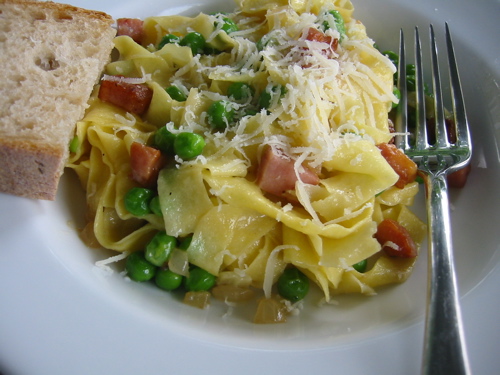
…is pretty much all this is. We’ve had a sparse, late pea season here in Kentucky this year, but man, are the ones we have ever sweet. Blanch two cups of them for two minutes, then immerse them in a cold water bath. Next, heat two tablespoons of olive oil and a tablespoon of butter in your largest sauté pan. Add two finely diced onions. Cook them gently until the onions are transparent. Next add six ounces of cubed slab bacon if you can find it. Here I used smoked hog jowls, which can be found in pretty much any grocery store here in Kentucky (God bless this wonderful state). They’re a great local substitute for Italian guanciale.
Brown the bacon to your liking, then add the peas and several turns of fresh ground black pepper. Warm the peas for about two minutes, then add a pound of fresh pasta that you’ve only just softened in a pot of amply salted water, plus a few tablespoons of the pasta water. Toss the pasta over the heat until it is only slightly firm. Portion out onto plates, top with fresh grated Parmigiano-Reggiano and hand to your guests. Expect no conversation until every last sweet and porky ribbon is consumed.
This is one of those dishes that really must be tried to be believed. Of course it all hinges on the freshness of the ingredients, especially the peas, but fresh pasta makes a big difference. Happily, you don’t need to have any experience with pasta or pasta machines to make the required noodles: tagliatelle, a word which simply means “cut things” in Italian. The only equipment you need is a big, ol’ rolling pin:
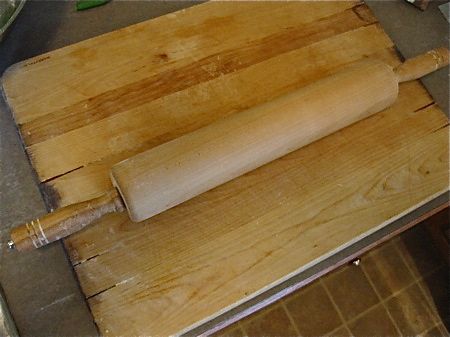
Separate a small lump of dough from the larger portion you previously made (keeping the rest tightly wrapped in plastic to keep it from drying out). It should be soft(ish) and plastic.

Flour your board and start to roll, without much regard for the final shape. The trick to rolling pasta in this way is to apply a good deal of pressure, and to roll fairly quickly back and forth, all the way out to the edges of the dough. It’ll take some effort, but if you lean in over the rolling pin, using your body weight instead of your arm strength to create the pressure, you won’t get tired.
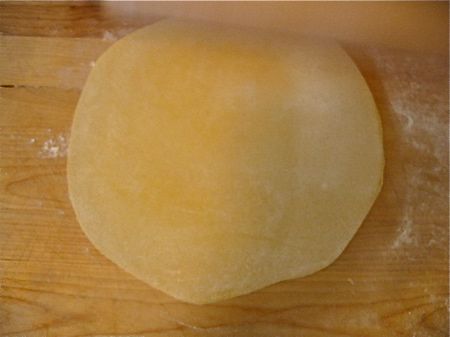
Here you can see the pasta starting to roll out. You’ll want to turn the sheet over every so often to keep it from sticking to the board. Simply apply a dusting of flour and keep going.
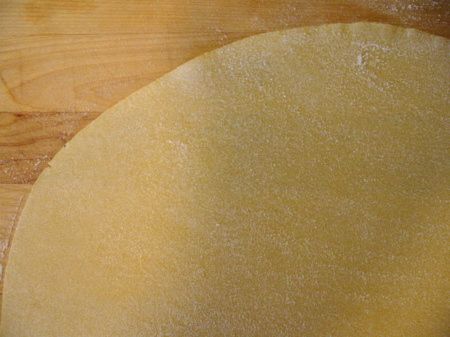
You’ll be amazed at how the dough will keep stretching without springing back. You can roll it almost impossibly thin, though I stop when I can begin to see the grain of my pastry board through the sheet.
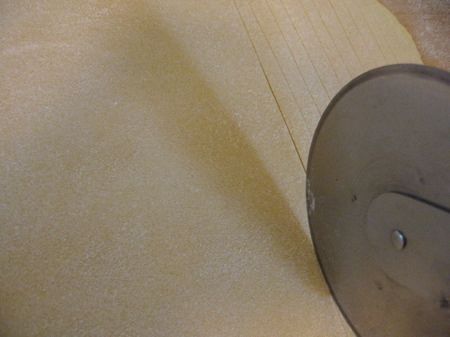
At this pint it’s ready to cut. You can use a sharp knife, though I like my trusty pizza cutter. Don’t get all uptight over consistency here (and in fact I cut mine a little thin for tagliatelle here, they were more like fettucine). It’s the thickness of your sheet that will determine how evenly the pasta cooks, not the width of the noodles. And anyway, the inconsistency will give your finished dish a nice, rustic flair.
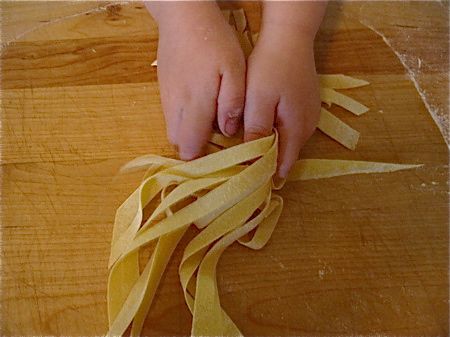
Scoop it up (or have your 3-year-old apprentice do it for you) and put it on a sheet pan, covered with a clean dish towel. Once all the pasta is rolled you can put it in the refrigerator until needed (remember, there are raw eggs in it, and though contamination isn’t terribly likely, it pays to be careful). When it’s this fresh it’ll cook up in just a minute or so, which makes timing a pasta dish like this very easy. You simply have your pot of water on the boil as you cook up your onions and your bacon, and drop the pasta at the same time you add your peas to the “sauce”.